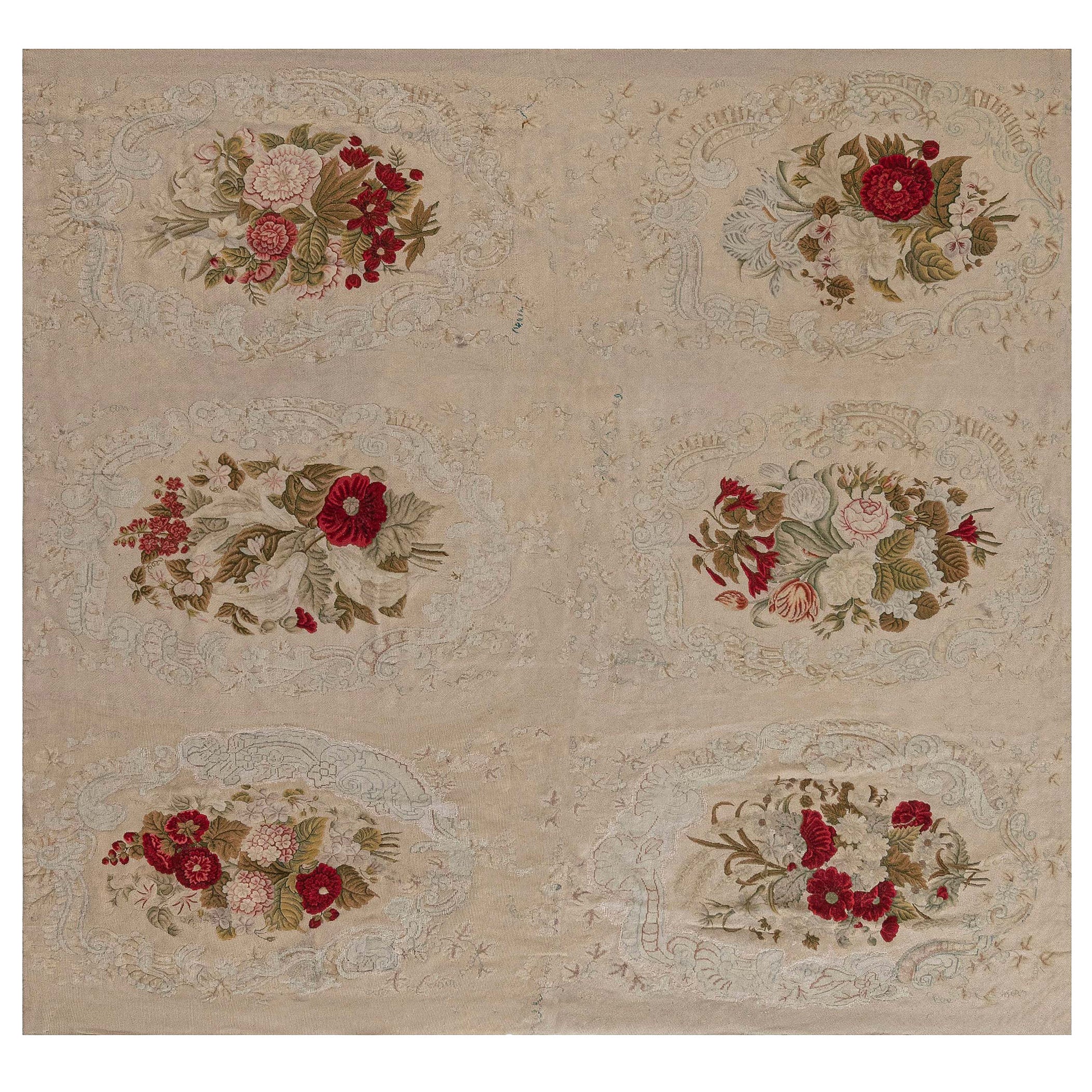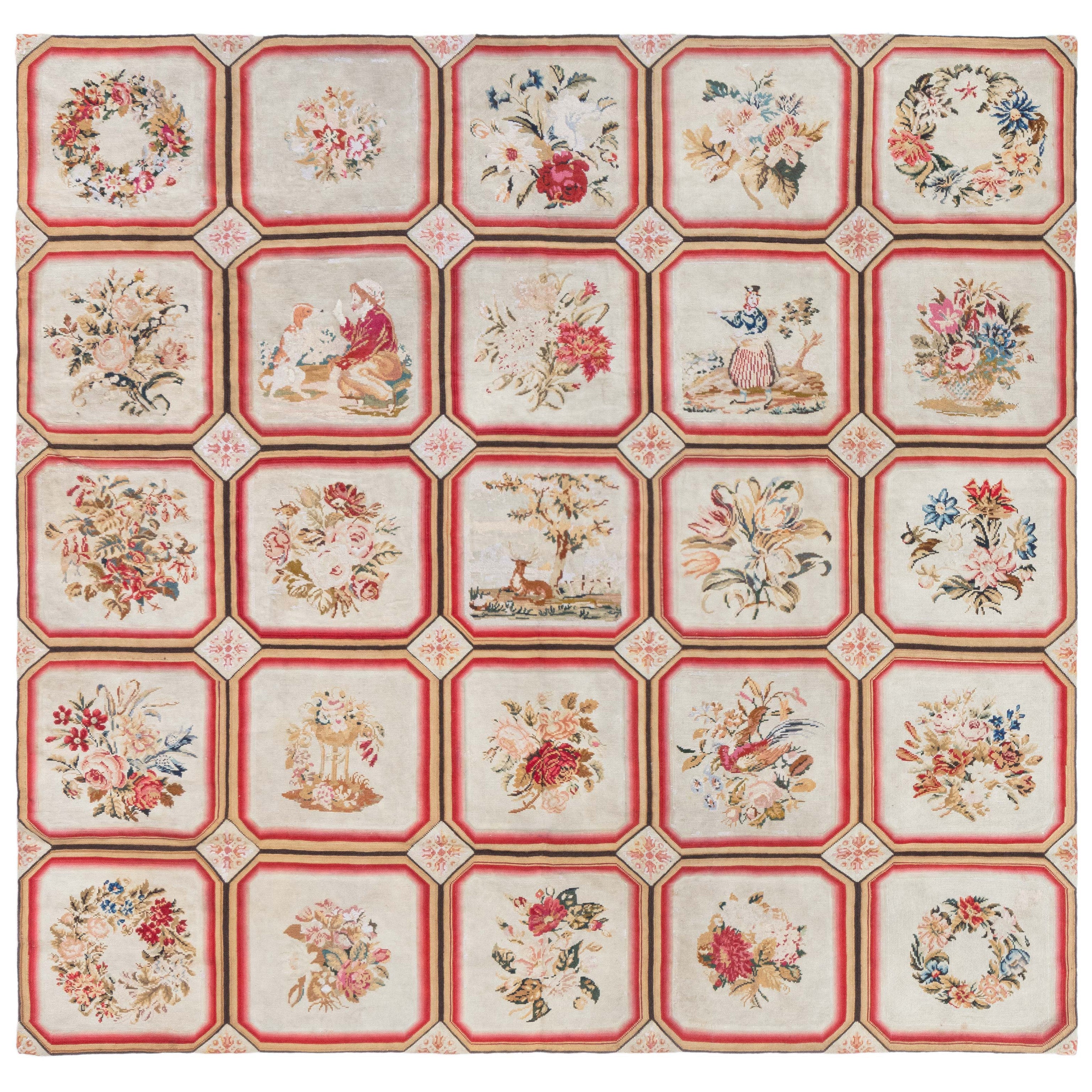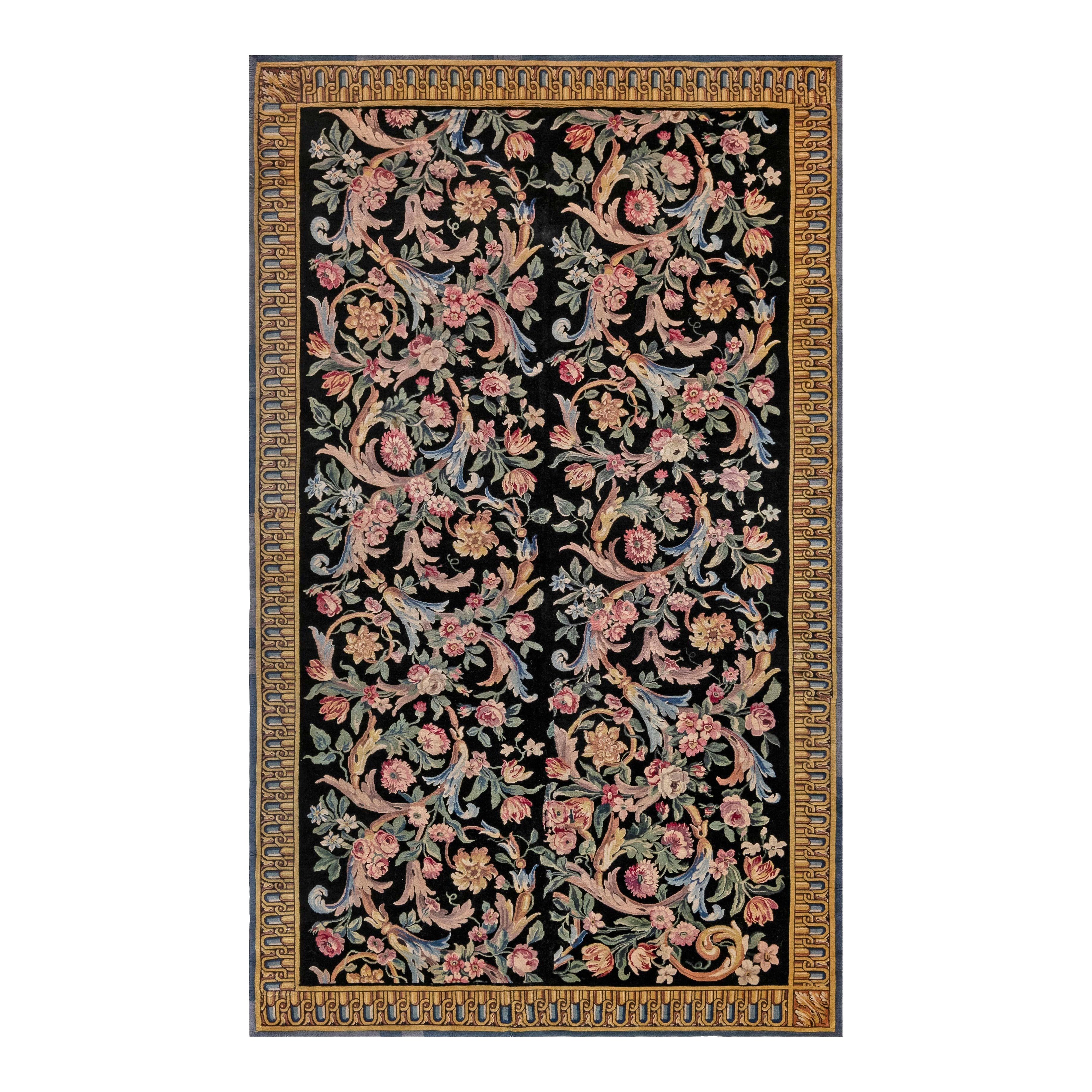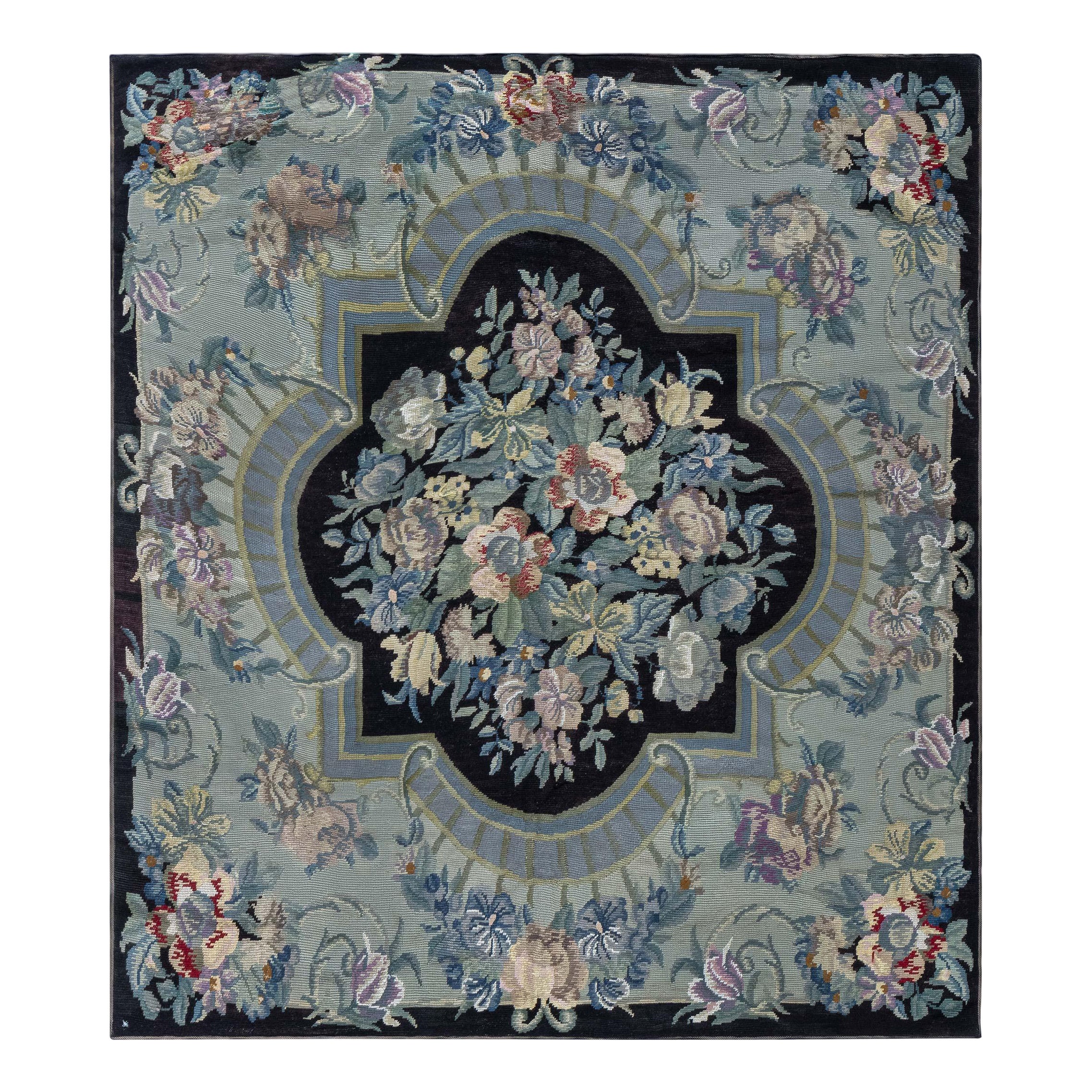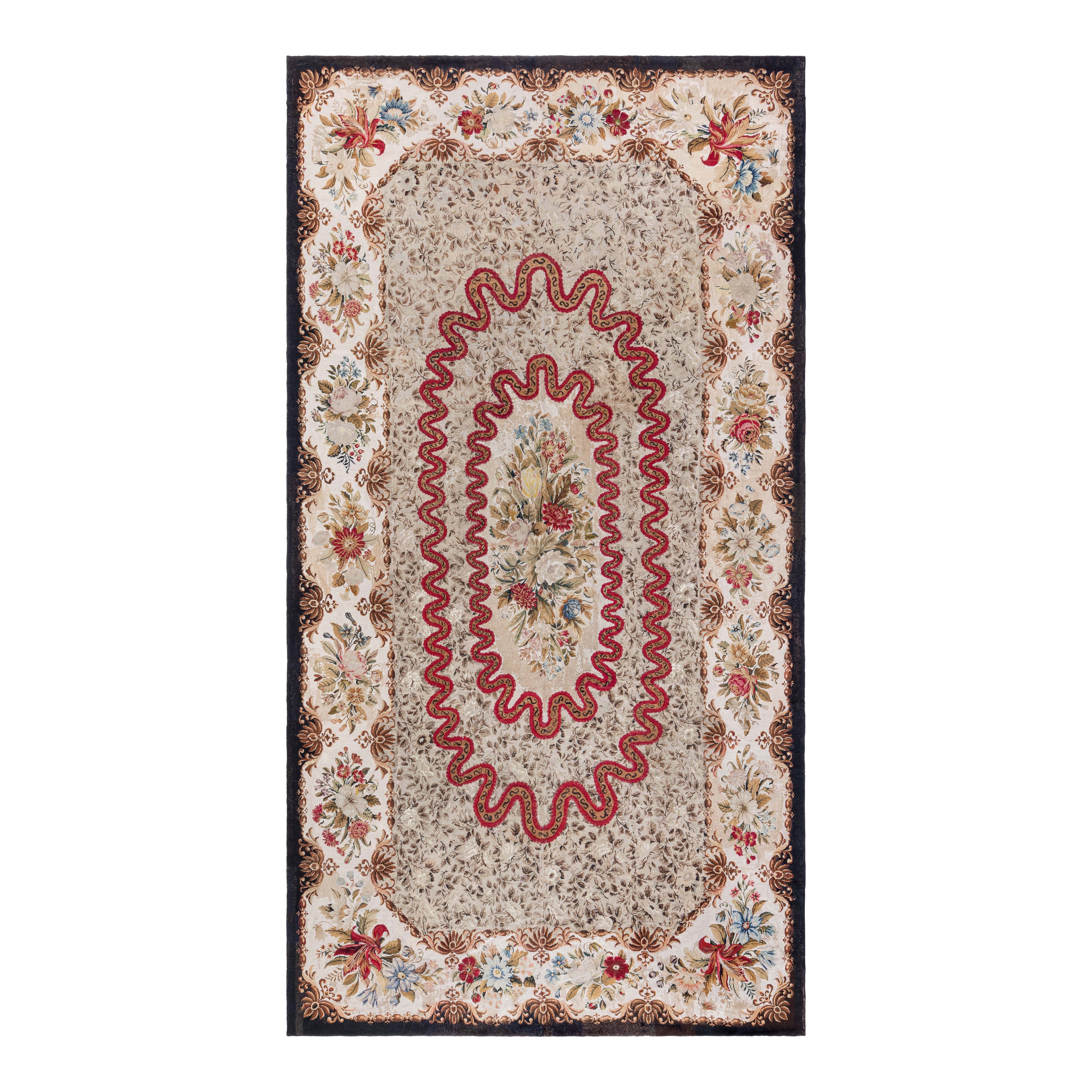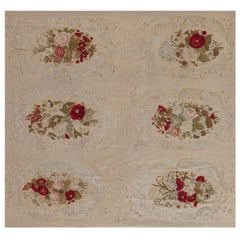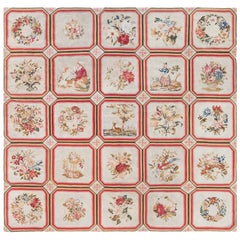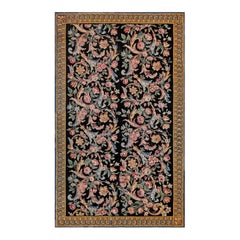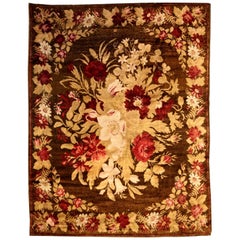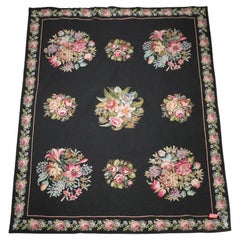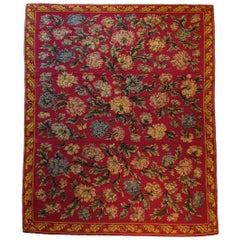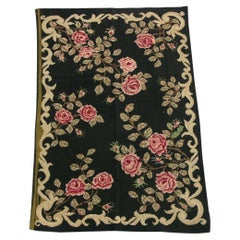Items Similar to Doris Leslie Blau 1950s European Needlework Rug
Want more images or videos?
Request additional images or videos from the seller
1 of 9
Doris Leslie Blau 1950s European Needlework Rug
$8,000
£6,131.03
€7,046.54
CA$11,236.39
A$12,575.60
CHF 6,582.88
MX$152,770.70
NOK 83,585.79
SEK 78,877.47
DKK 52,579.61
About the Item
1950s European Needlework Rug
Size: 9'7" × 10'0" (292 × 304 cm)
Vibrant and meticulously detailed, this 1950s European needlepoint rug exudes mid-century elegance with its vivid palette and graphic floral arrangements. Each octagonal panel features a central bouquet of lush roses, peonies, and foliage, rendered in bold shades of crimson, pink, ivory, gold, and green, set against a deep black background that enhances their dramatic impact.
The layout is symmetrical and structured, with each floral cluster framed by a geometric lattice of rich rust and amber borders, punctuated by stylized medallions at the intersections. The combination of naturalistic floral imagery with a refined grid framework creates a dynamic interplay between romantic softness and architectural order.
Executed in fine wool using traditional hand-stitching techniques, the rug showcases the enduring artistry of European needlework traditions. The use of high-contrast colors and pixelated precision recalls the visual richness of petit-point embroidery, making it as much a visual artwork as a floor textile.
Ideal for interiors seeking a bold, vintage character, this rug works beautifully in eclectic, traditional, or maximalist design schemes.
Rich in heritage and artistry, this handmade rug exemplifies the high standards of Doris Leslie Blau’s curated pieces. With a wide range of prices, Doris Leslie Blau makes exceptional rugs accessible to collectors and designers alike.
- Dimensions:Width: 115 in (292.1 cm)Length: 120 in (304.8 cm)
- Materials and Techniques:Wool,Needlework
- Place of Origin:
- Period:
- Date of Manufacture:Mid-20th Century
- Condition:
- Seller Location:New York, NY
- Reference Number:Seller: BB69411stDibs: LU822639258882
About the Seller
4.8
Gold Seller
Premium sellers maintaining a 4.3+ rating and 24-hour response times
Established in 1965
1stDibs seller since 2006
242 sales on 1stDibs
Typical response time: 4 hours
- ShippingRetrieving quote...Shipping from: New York, NY
- Return Policy
Authenticity Guarantee
In the unlikely event there’s an issue with an item’s authenticity, contact us within 1 year for a full refund. DetailsMoney-Back Guarantee
If your item is not as described, is damaged in transit, or does not arrive, contact us within 7 days for a full refund. Details24-Hour Cancellation
You have a 24-hour grace period in which to reconsider your purchase, with no questions asked.Vetted Professional Sellers
Our world-class sellers must adhere to strict standards for service and quality, maintaining the integrity of our listings.Price-Match Guarantee
If you find that a seller listed the same item for a lower price elsewhere, we’ll match it.Trusted Global Delivery
Our best-in-class carrier network provides specialized shipping options worldwide, including custom delivery.More From This Seller
View All1880s Antique French Botanic Needlepoint Rug Doris Leslie Blau
Located in New York, NY
1880s Antique French Botanic Needlepoint Rug
Size: 7'2" × 7'5" (218 × 226 cm)
A masterful example of late 19th-century French textile artistry, this antique needlepoint rug from the ...
Category
Early 20th Century French Western European Rugs
Materials
Wool
Doris Leslie Blau Antique English Needlepoint Rug
Located in New York, NY
Antique English Needlepoint Rug
Size: 7'0" × 7'0" (213 × 213 cm)
This antique English needlepoint rug, dating back to the early 20th century, is a charming example of traditional nee...
Category
Early 20th Century English Western European Rugs
Materials
Wool
Doris Leslie Blau Antique French Savonnerie Rug (size adjusted)
Located in New York, NY
Antique French Savonnerie Rug (size adjusted)
Size: 5'0" × 8'6" (152 × 259 cm)
This exquisite antique Savonnerie rug, dating from the 1920s, beautifully exemplifies the grandeur and ...
Category
Early 20th Century French Western European Rugs
Materials
Wool
Doris Leslie Blau Antique Ukrainian Wool Rug
Located in New York, NY
Antique Ukrainian Wool Rug
Size: 7'2" × 9'2" (218 × 279 cm)
This splendid antique Ukrainian wool rug from the 1880s is a prime example of Bessarabian textile artistry, merging rustic...
Category
Antique Late 19th Century Ukrainian Caucasian Rugs
Materials
Wool
Doris Leslie Blau 1920s English Needlepoint Rug with Floral Medallion Design
Located in New York, NY
1920s English Needlepoint Rug with Floral Medallion Design
Size: 4'8" × 4'10" (142 × 147 cm)
This exquisite antique English needlepoint rug, circa 1920, radiates timeless elegance an...
Category
Early 20th Century English Western European Rugs
Materials
Wool
Antique 19th Century European Needlepoint Rug Doris Leslie Blau
Located in New York, NY
Antique 19th Century European Needlepoint Rug Doris Leslie Blau
Size: 10'0" × 18'0" (304 × 548 cm)
This exquisite European needlepoint rug from the 1880s is a remarkable testament to...
Category
Antique Late 19th Century French Western European Rugs
Materials
Wool
You May Also Like
1950s Vintage Floral Design Needlepoint Rug
Located in Los Angeles, US
Ancient Roots Of Needlepoint Rugs
Archaeologists and scholars consider the roots of needlepoint to have been around 1500 BC. They consider the first needlepoint to include the fine diagonal stitches that were used to sew tents together by the ancient Egyptians. The art eventually evolved into tapestry weaving. However, a tapestry weaving differs significantly from needlepoint in that it uses a loom and vertical warp.
Tapestry weaving is closer to the weaving of kilims and pile rugs than canvas work. However, some still include tapestry weaving in the category of needlepoint because of the fine work that appeared during the late Renaissance. It can have a similar appearance to the untrained eye. Technically, tapestry weaving and needlepoint are not the same, and they do not use the same technique.
The first actual needlepoint rugs and needle-points began to appear in the late Renaissance. Needlepoint is worked by creating stitches on a stiff canvas. The canvas is typically made from jute or linen and is quite durable. Pieces from the Renaissance were used to cover footstools, chairs, pillows, bed headboards, and other furnishings. They were also used as table coverings and wall coverings. You could also find them on many small items such as purses, shoes, and various adornments for clothing.
During the Renaissance, the craft reached a high level of skill, and the designs became incredibly detailed and realistic. They mimicked many of the subjects and styles of famous paintings of the time. They created florals, still life designs, scenes, and geometric tiled pieces. Some of them mimicked the designs found in Persian Carpets.
Needlepoint reached its peak popularity in the 19th century when it was considered a proper occupation for a lady. Needlepoint and embroidery held a similar place in societal status at the time. During this time, the work became finer, with some of the canvas reaching a high level of detail. The level of detail is determined by counting the number of mesh in an inch. During this time petit point by French needlewomen could have a mesh count as high as 45 mesh. This allowed women to create highly intricate designs with incredible levels of detail.
Historical Needlepoint Carpets and Rugs
It is possible to find many antique pieces of needlepoint besides rugs. Needlepoint rugs were popular in France and Spain, where the technique was adapted to create highly intricate designs that mimicked the designs in architecture and fashion. They were popular because they were durable, and it could be fashioned into a variety of items. The canvases themselves were durable, and the wool that they used was also strong, which means that many of the pieces were able to withstand daily use. We have many artifacts that have survived from this time period.
Needlepoint rugs are important collectibles because they are different from the pile rugs and kilims that are typically found on the market. Needlepoint carpets are special because they take many hours to create, especially larger works. Needlepoint pieces of any type became popular throughout Europe during the 19th century. It is still a popular hobby today, but perhaps one of the most interesting stories is that of the Portuguese needlewomen of Arraiolos.
The story of these women and their beautiful carpets begins in 1492. Needlepoint was a popular occupation in Spain, which had a large population of Moors and Jews. They were an integral part of Spanish culture. However, in 1492, Queen Isabella of Spain issued a proclamation that gave these ethnic groups the order to pack their bags and board ships headed...
Category
Vintage 1950s Other Russian and Scandinavian Rugs
Materials
Wool
Vintage Floral Needlepoint Rug Tapestry - 9’ W x 12’ L
Located in Pittsburgh, PA
This large-scale vintage needlepoint rug / tapestry features a striking black ground, punctuated by alternating large and small bouquets of multicolored flowers. The floral motifs ar...
Category
Late 20th Century American North and South American Rugs
Materials
Wool
669 - 19th Century Needlepoint Rug Floral
Located in Paris, FR
669 - 19th century needlepoint rug floral.
Category
Antique 1880s French Aubusson Western European Rugs
Materials
Wool
Antique Needlework Floral Rug
Located in Los Angeles, US
Needlepoint rugs were created using the traditional needlework weaving technique that is used to make everyday items from furniture to carpets and artwork. However, it has a fascinat...
Category
Antique Early 1900s Asian Other Russian and Scandinavian Rugs
Materials
Wool, Cotton
Floral English Needlepoint Rug, 19th Century
Located in San Francisco, CA
Floral Decorative English Needlepoint Rug, 19th Century (4th Quarter)
Additional Information:
Dimensions: 7'9" W x 11'1" L
Origin: England
Period: 19th Century (4th Quarter)
Rug ID:...
Category
Antique 19th Century English Western European Rugs
Materials
Wool
1920s Antique Floral Design Part Silk Needlework Rug
Located in Los Angeles, US
Needlepoint rugs were created using the traditional needlework weaving technique that is used to make everyday items from furniture to carpets and artwork. However, it has a fascinating history both as a hobby and as an industry. When many people think of carpets, they think of pile carpets or flat weave kilims, but needlepoint has also been used to create beautiful carpets. These carpets are durable and an important part of carpet history.
Archaeologists and scholars consider the roots of needlepoint to have been around 1500 BC. They consider the first needlepoint to include the fine diagonal stitches that were used to sew tents together by the ancient Egyptians. The art eventually evolved into tapestry weaving. However, a tapestry weaving differs significantly from needlepoint in that it uses a loom and vertical warp.
Tapestry weaving is closer to the weaving of kilims and pile rugs than canvas work. However, some still include tapestry weaving in the category of needlepoint because of the fine work that appeared during the late Renaissance. It can have a similar appearance to the untrained eye. Technically, tapestry weaving and needlepoint are not the same, and they do not use the same technique.
The first actual needlepoint rugs and needle-points began to appear in the late Renaissance. Needlepoint is worked by creating stitches on a stiff canvas. The canvas is typically made from jute or linen and is quite durable. Pieces from the Renaissance were used to cover footstools, chairs, pillows, bed headboards, and other furnishings. They were also used as table coverings and wall coverings. You could also find them on many small items such as purses, shoes, and various adornments for clothing.
During the Renaissance, the craft reached a high level of skill, and the designs became incredibly detailed and realistic. They mimicked many of the subjects and styles of famous paintings of the time. They created florals, still life designs, scenes, and geometric tiled pieces. Some of them mimicked the designs found in Persian Carpets.
Needlepoint reached its peak popularity in the 19th century when it was considered a proper occupation for a lady. Needlepoint and embroidery held a similar place in societal status at the time. During this time, the work became finer, with some of the canvas reaching a high level of detail. The level of detail is determined by counting the number of mesh in an inch. During this time petit point by French needlewomen could have a mesh count as high as 45 mesh. This allowed women to create highly intricate designs with incredible levels of detail.
It is possible to find many antique pieces of needlepoint besides rugs. Needlepoint rugs were popular in France and Spain, where the technique was adapted to create highly intricate designs that mimicked the designs in architecture and fashion. They were popular because they were durable, and it could be fashioned into a variety of items. The canvases themselves were durable, and the wool that they used was also strong, which means that many of the pieces were able to withstand daily use. We have many artifacts that have survived from this time period.
Needlepoint rugs are important collectibles because they are different from the pile rugs and kilims that are typically found on the market. Needlepoint carpets are special because they take many hours to create, especially larger works. Needlepoint pieces of any type became popular throughout Europe during the 19th century. It is still a popular hobby today, but perhaps one of the most interesting stories is that of the Portuguese needlewomen of Arraiolos.
The story of these women and their beautiful carpets begins in 1492. Needlepoint was a popular occupation in Spain, which had a large population of Moors and Jews. They were an integral part of Spanish culture. However, in 1492, Queen Isabella of Spain issued a proclamation that gave these ethnic groups the order to pack their bags and board ships headed...
Category
Vintage 1920s Renaissance Revival Russian and Scandinavian Rugs
Materials
Wool, Silk
More Ways To Browse
1950s Embroidery
Needlework Framed
Petit Architectural
Amber Bar Set
Peonies Embroidery
English Leather Chair
Ethnic Chairs
Fluted Console Table
Mosaic Panel
Stainless Mid Century Chair
Tapered Legs Game Table
Woven Leather Chair
Black Velvet Sofas
Chrome Sofa Italian
Curved Sofa Tables
Italian Sofa In Red
Limited Edition Ceramics
Queen Anne Style Side Table
